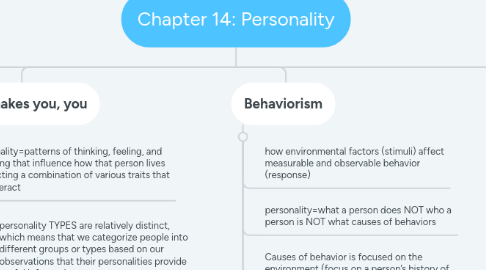
1. The Trait Approach
1.1. ignore the causes of personality and focuses instead on measuring and describing how people differ, how some traits tend to interact,
1.1.1. and on determining how many unique traits are needed to adequately describe human personality and predict human behavior
1.2. dimensional approaches, where people are seen as varying along some dimension
1.3. categorical, meaning that they identify people as belonging to particular clusters that are associated with different combinations of trait
1.4. THE BIG FIVE (OCEAN)
1.4.1. Openness- curious, original, intellectual, creative, open to new ideas
1.4.2. Conscientiousness- original, systematic, punctual, achievement oriented, dependable
1.4.3. ExtrAversion- outgoing, talkative, sociable, enjoying social situations
1.4.4. Neuroticism-anxious, irritable, volatile/temperamental, moody
2. Humanism
2.1. we have free will and are all striving to be better, sometimes life just gets in the way
2.1.1. emphasizes empathy and stresses good in human behavior
2.2. Self actualization- humanistic motive that is the concept of striving for improvement.
2.2.1. we are working toward the best version of ourselves that we can be
2.3. >>Problem: unable to account for a number of pieces of evidence including genetic predisposition and the weak effects associated with shared environments.
3. What makes you, you
3.1. Personality=patterns of thinking, feeling, and behaving that influence how that person lives =reflecting a combination of various traits that will interact
3.1.1. personality TYPES are relatively distinct, which means that we categorize people into different groups or types based on our observations that their personalities provide useful information.
3.1.2. patterns or predispositions are relatively consistent. not perfectly consistent, because the situation and social influences will have big effects on our behaviors, but can use personality to predict how someone will react in a new situation.
3.2. personality has a strong heritable (estimate of how much of a trait can be explained by genes and how much can be explained by environment) component recall: just like intelligence: heritability of personality traits are never 100%.
3.2.1. Genes can control hormone production and in turn influences your (ie) levels of aggression.
3.2.2. Environment can also influence biological factors (ie. winning a competition of some sort you will have a boost in your testosterone levels) =
3.2.3. Biology and environment have reciprocal actions, so you can’t think of them as having completely separate influences or outcomes.
3.2.3.1. Researchers focus on shared environments compared to nonshared environments. = It seems that nonshared environments contribute more to personality than shared environments. = not all kids in the same family will end up with the same personalities, their personalities will be heavily influenced by all of those different experiences that they have.
3.2.3.2. Can’t estimate how much is because of your genes and how much is because of your experience. Statistically impossible. Can estimate effects for groups not individuals
4. Behaviorism
4.1. how environmental factors (stimuli) affect measurable and observable behavior (response)
4.2. personality=what a person does NOT who a person is NOT what causes of behaviors
4.3. Causes of behavior is focused on the environment (focus on a person’s history of punishment and reinforcement for behaviours or a person’s history of learning particular associations).
4.3.1. we aren’t always aware of our behaviors or why we do them
4.4. >>Problem: generally fails to incorporate genetic predisposition, and it can’t account for that evidence that shared environment doesn’t have much unique contribution to personality
4.4.1. e.g.) parent why finds crowds to be fun and exciting but son does not?
5. Early psychological views
5.1. Psychoanalytic/Psychodynamic View [FREUD]
5.1.1. your experiences interact with your very active unconscious mind to produce behaviors that are design to protect you from scary thoughts
5.1.1.1. active unconscious mind--people aren’t always consciously aware of why they do things. In some cases, we aren’t even aware that we are doing some things
5.1.1.1.1. id - raw, primitive, instinctual part -selfish focused on immediate gratification
5.1.1.1.2. superego - overarching sense of morality, impossible standard between right and wrong. -moral conscience
5.1.1.1.3. Ego- rational part=balance between the desires of id and superego
5.1.1.1.4. personality results from experience with conflicts, differences come from varying strengths of (^)
5.1.2. Defense Mechanisms-help us to deal with internal conflict, reduce anxiety and keep us mentally healthy.
5.1.3. >>Problem: many of its claims are unfalsifiable can’t be adequately tested, or that they have been directly refuted by evidence)
5.1.3.1. Modern knowledge that genetic predisposition predicts a lot of personality, and shared environment does not. Psychoanalytic theories can’t account for the heritability of personality.
6. How Personality is Measured
6.1. Structured personality test
6.1.1. ask people to indicate their preferences and indicate the extent to which particular words or concepts describe them.
6.1.2. e.g.)Myers-Briggs Type Indicator which was loosely based off of Carl Jung’s psychodynamic ideas; popularity ≠ quality
6.1.3. *good interrater reliability because it is based on concrete numerical scores *low validity, meaning that it doesn’t seem to predict anything particularly useful about behavior, *low reliability, because people can get very different results each time they take it.
6.2. criterion validity= a test is able to distinguish between people in different categories
6.3. reliable, with regard to both test-retest reliability and interrater reliability- degree of agreement among raters
6.4. Projective personality test
6.4.1. ambiguous stimuli are shown and then the person is asked to tell a story or provide other feedback about the item in order to reveal aspects about their personalities
6.4.1.1. idea here is not to systematically ask questions of the person, but rather to let them reveal things about themselves that can then be interpreted.
6.4.2. e.g.) the classic Rorschach Test presents you with inkblots and asks you what you see in them.
6.4.3. e..g) TAT or Thematic Apperception Test where you look at a picture of a scene and be asked to tell as story about that scene
6.4.4. *very poor validity and reliability.

